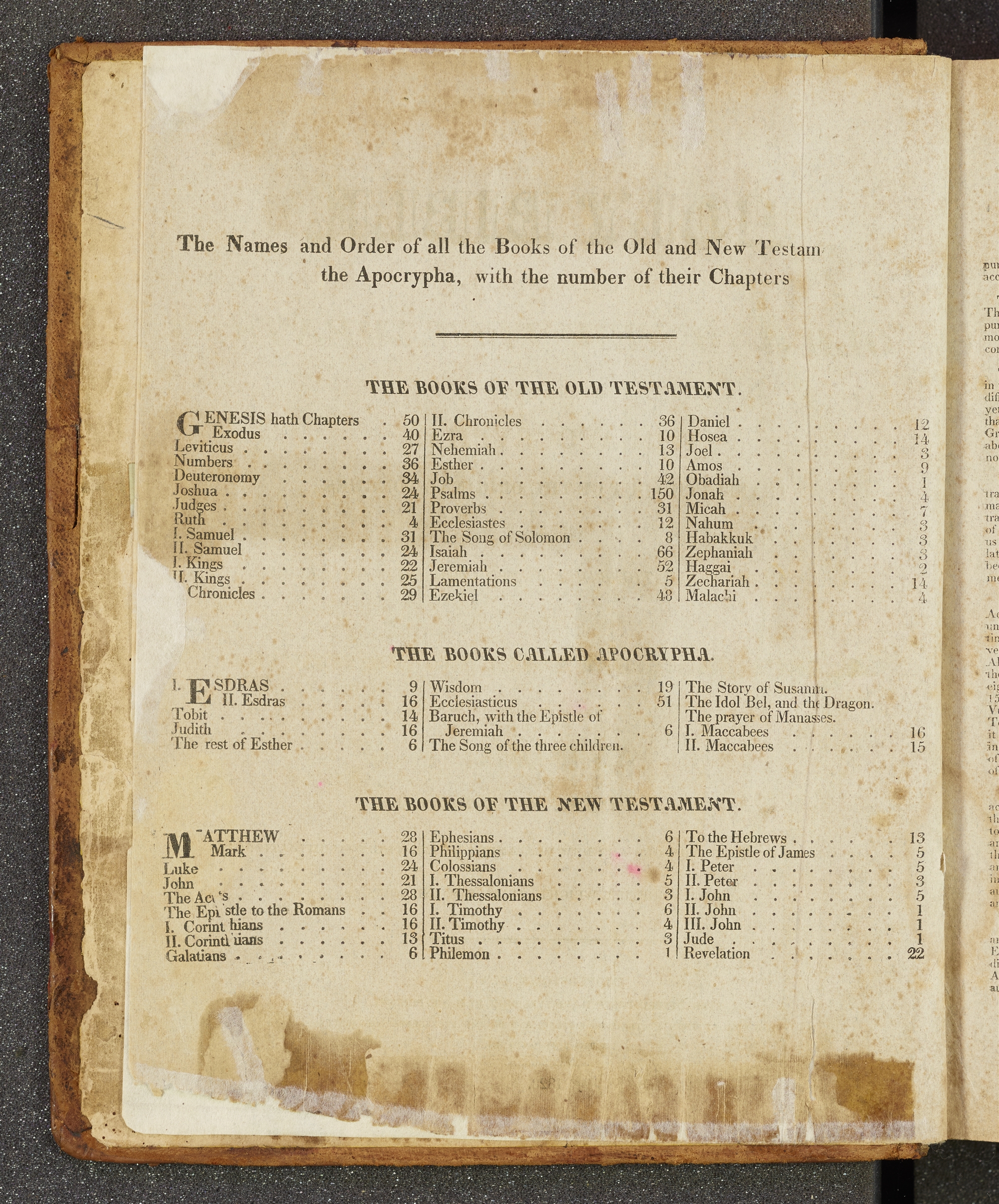Most Bibles today contain 66 books, divided into the Old Testament (39 books) and the New Testament (27 books). Modern Latter-day Saint KJV Bibles contain the same number.
Joseph Smith’s KJV Bible, on the other hand, contained 80 books divided into three sections: an Old Testament, a New Testament, and a section in between titled “The Books Called the Apocrypha.”
Until recent centuries, it was fairly standard for Bibles to include the Apocrypha (Catholic Bibles continue to include it today). So where did these extra 14 books go—and how did they get into the Bible in the first place?

What is the Apocrypha?
Two terms are closely related but often confused: Apocrypha and apocryphal.
The word apocrypha comes from a Greek word meaning “to hide away,” and apocryphal is its English adjective. The term originally referred to writings that were esoteric, “hidden,” or reserved for private teaching. Over time, it came to mean works whose origin or authority was considered uncertain.
“The Apocrypha” (capital A), however, usually refers to a collection of 14 books included today in Catholic Bibles but typically excluded from Protestant ones. Like the Bible itself, these writings are diverse: some are historical, some prophetic, and others resemble wisdom literature like Proverbs.
The Orthodox Church accepts additional writings beyond the Catholic 14, so sometimes a distinction is made between the Catholic and Orthodox Apocrypha. When no distinction is made, however, the Catholic Apocrypha is usually what is meant. Various branches of Orthodoxy, including Eastern and Oriental Orthodox, recognize additional books, while the Ethiopian canon is broader still. To avoid the negative connotations of the word apocrypha, the term deuterocanonical is sometimes used instead.
Where did the Apocrypha Come From?
It is not fully known where the Apocrypha originated from, but they first appeared in canonical form in the Septuagint—a Greek translation of the Old Testament dating to around 250 BC. Because these books were not found in the Hebrew Bible, later Jewish rabbis did not treat them with the same authority. Early Christians, however, largely accepted them because they read from the Septuagint. In fact, before the Reformation, the Apocrypha was almost always included in Christian Bibles and widely used as scripture.
Some early voices differed on how to classify them. Jerome, translator of the Latin Vulgate, preferred the Hebrew canon but still included the Apocrypha from the Septuagint—acknowledging their use despite the lack of Hebrew originals. Clement of Alexandria quoted the Apocrypha alongside other scriptures, and the Third Council of Carthage declared them part of the canon.
In other words, while some argued they were worth reading but secondary to other scripture, the Apocrypha was unquestionably part of the Bible for most early Christians.
Why isn’t the Apocrypha in Bibles Today?
The Apocrypha’s acceptance began to shift as a result of the Protestant Reformation. A number of Catholic doctrines—such as purgatory, salvation through works, and unique beliefs about angels—all found support in the Apocrypha, but stood at odds with Protestant interpretations of the New Testament.
Martin Luther himself did not reject the Apocrypha outright; his 1534 German Bible prefaced it by stating, “These books are not held to be equal to Holy Scripture, but they are useful and good to read.” Over time, however, Protestants gave it less weight, partly due to suspicion over the Apocrypha's non-Hebrew origins.
In the early 1800s, mounting pressure from Presbyterians resulted in some publishers dropping the Apocrypha from their Bibles. The British Bible Society began omitting it in 1826, citing printing cost. In the KJV, it remained until 1885.
Latter-day Saints and the Apocrypha
As a whole, Latter-day Saints are typically more keen on the Apocrypha than Protestants are. This is partially due to Doctrine and Covenants Section 91. While working on his inspired translation of the Bible, Joseph Smith asked about the Apocrypha and received this answer:
It contains many things that are true.
It also contains human interpolations.
Those guided by the Spirit can profit from it; those without the Spirit will not.
Therefore, it was not needful for him to translate it.
Latter-day Saints are also shaped by the principle of an “open canon.” Unlike mainstream Christianity, which holds the canon closed, the Church includes the Book of Mormon, Doctrine and Covenants, and Pearl of Great Price. This openness predisposes us to look for truth beyond the traditional 66 books.
Another Revelation, Doctrine and Covenants 107, also inclines Latter-day Saints to accept apocryphal works. The revelation recounts Adam’s last days, when he called his descendants to him and “predicted whatsoever should befall his posterity.” The revelation continues, “These things were all written in the Book of Enoch, and are to be testified of in due time.” This passage does not explicitly endorse the text we know today as 1 Enoch, but it does affirm that an Enoch record once existed—a tradition also preserved in various pseudepigrapha. This book, though never included in the Apocrypha, is lowercase apocryphal. Sometimes scholars will use the term pseudepigrapha to avoid confusion. Figures such as Enoch, Melchizedek, and Joseph receive expanded treatment in both Latter-day Saint scripture and in pseudepigraphal works. This overlap naturally sparks Latter-day Saint curiosity about lost texts.
In a 2006 General Conference talk, then Elder Oaks stated:
“We conclude from this that the Lord will eventually cause the inspired teachings He has given to His children in various nations to be brought forth…The finding of the Dead Sea Scrolls shows one way this can occur. When new writings come forth—and according to prophecy they will—we hope they will not be treated with the rejection some applied to the Book of Mormon because they already had a Bible.”
Whether Apocrypha, pseudepigrapha, or newly discovered scrolls, Latter-day Saints often feel that hidden truths may yet emerge.
Still, a word of caution is helpful: in our excitement to explore hidden or “lost” writings, we should never neglect the canonized scriptures God has already given. The Book of Mormon, Doctrine and Covenants, Pearl of Great Price, and the Bible remain the foundation of our study and discipleship.
Like Mormonr? Sign up for our newsletter to receive updates on the latest blog posts, Q&As, and Mormonr projects.


